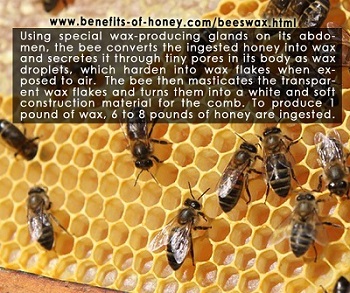
How is Beeswax Made?
Beeswax is used to construct the combs in which the bees raise their young and store pollen and honey. It is a natural wax that comprises mainly esters of fatty acids and various long chain alcohols. But how is beeswax made? What is it made of?
Female worker bees, whose lifespan is about four weeks, possess eight special wax-producing glands on their abdomens. The young worker bees are most efficient at wax production. Their wax glands start to degenerate after plus-minus 18 days until the end of its life.
Beeswax is made by these bees through the consumption of honey produced from the collected flower nectar. To produce one pound of wax, six to eight pounds of honey are ingested (Source: Beeswax Production, Harvesting, Processing and Products, Coggshall and Morse. Wicwas Press. 1984-06-01).

The sugar converted by the bee's wax glands is then secreted through tiny pores in the bee's body as wax droplets, which harden into wax when exposed to air. The wax looks like small, transparent scales on the bees' abdomen. After being chewed and processed by the bees' salivary secretions, the wax scales turn into white color and become soft and pliable enough to be used as a construction material for the bees' comb. As high temperature would soften the beeswax too much and low temperature would render the beeswax too hard, the honeybees have to use their body heat to regulate the ambient temperature of the hive and maintain it such that it is most ideal temperature for managing the beeswax - about 95 degrees Fahrenheit (35 degrees Celsius).
At first, the honeycomb which comprises hexagon shaped cylinders is glass clear and colorless but its color gradually changes with the incorporation of honey, pollen and propolis, and darkens with age and use for raising brood. Depending largely on the type of honey and pollen, the color of beeswax varies from white, through different tones of yellow, orange, red to brownish black. Beeswax color may have aesthetic significance but does not have any quality implications. Commercial white beeswax is obtained by filtering and naturally removing the colour without any use of chemicals, which is the preferred way from the perspective of the consumer but is also often obtained by some suppliers through simpler but harsher processes of bleaching using ionization, sulphuric acid or hydrogen peroxide.
Related Pages
1. If you are located in Singapore, checkout 100% pure beeswax beads, pellets, and blocks at: Bee Healthy
2. Bee wax has a lot more uses than you probably know: Bee Wax Uses You Probably Don't Know
3. Discover why beeswax candles are more superior than regular candles: Beeswax Candles Versus Paraffin Candles
4. Why are the cells of beehive honeycomb hexagonal in shape? More in: Hexagonal Honeycomb Pattern
End of "How is Beeswax Made?". Back to Honey Bees and Their Wondrous Products.